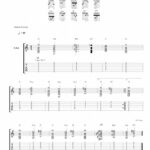The electric guitar, beyond being a musical instrument, is a canvas for artistic expression, and nowhere is this more evident than in the diverse and often unique shapes of its body. The body shape is the first visual element that captures attention, often becoming synonymous with a musician’s persona and musical style. From Jimi Hendrix’s iconic flipped-over Stratocaster® to Steve Vai’s signature Ibanez Jem® with its distinctive monkey grip, the body shape of an electric guitar is deeply intertwined with its identity and appeal.
This guide dives into the fascinating world of electric guitar bodies, showcasing a range of shapes from the classic curves of the Stratocaster® to the more avant-garde designs like the Explorer® and Flying V®. Each shape is a product of engineering innovation, ergonomic considerations, and a rich musical heritage.
The Significance of Guitar Body Shapes
Before we explore specific examples, it’s crucial to understand why body shape is such a vital aspect of electric guitar design.
The guitar body shape refers to the outline and form of the guitar's main structure, excluding the neck and headstock. This shape is fundamental in defining both the visual character and ergonomic properties of the instrument. It dictates how the guitar sits against the player's body and how easily the player can access different parts of the fretboard. While some shapes share similarities, like superstrats, each unique body shape contributes to a guitar's individual look and feel.Guitar body design is significant for numerous reasons:
- Aesthetic Impact: The shape is paramount to a guitar’s visual appeal. Iconic shapes, such as the Fender Stratocaster® or Gibson Les Paul®, are immediately recognizable and are embedded in the cultural iconography of electric guitars.
- Ergonomics and Playability: A guitar’s body shape heavily influences its comfort and playability. Factors like weight distribution, balance, and upper fret access are all determined by the body design. A well-designed body enhances player comfort, which in turn can improve playing technique and stamina.
- Subtle Sonic Qualities: While less impactful than in acoustic guitars, the body shape of an electric guitar can still subtly affect resonance and sustain. The distribution of mass and string interaction with the body can contribute to tonal nuances, although this is a debated topic with only a minor effect.
- Playing Position Comfort: Different body shapes cater to various playing styles and positions, whether seated or standing. Some shapes are better suited for seated playing, while others are optimized for stage performances.
- Brand and Model Identity: Body shape is a key identifier for guitar brands and models. It becomes part of their brand identity and marketing.
- Historical and Cultural Resonance: Many body shapes have historical significance, linked to specific musical eras, genres, or famous guitarists, like Jimi Hendrix and the Stratocaster®. This historical context can elevate a guitar’s desirability and perceived value.
Diverse Electric Guitar Body Shapes: 40 Notable Examples
Considering these factors, we present a compilation of 40 popular electric guitar body shapes, ranging from timeless classics like the Strat® and Les Paul® to contemporary designs such as the Strandberg Boden®. Each description includes design notes highlighting interesting and iconic aspects of the shape.
| Body Shape | Design Notes |
|---|---|
Fender Stratocaster®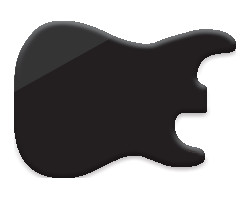 Fender Stratocaster Body Shape Fender Stratocaster Body Shape |
The Stratocaster’s double-cutaway body, featuring rounded edges and ergonomic contours—the arm contour (or forearm contour) and belly cut—revolutionized player comfort. Introduced in 1954 by Leo Fender, George Fullerton, and Freddie Tavares, it aimed to improve upon the Telecaster, offering better comfort and upper fret access. The Stratocaster’s body shape is not just iconic but also highly influential, becoming one of the most copied designs in guitar history and setting a benchmark for ergonomic electric guitar design. |
Gibson Les Paul®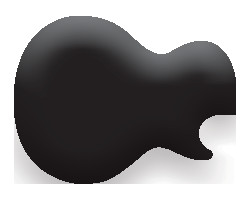 Gibson Les Paul Unique Body Shape Gibson Les Paul Unique Body Shape |
The Les Paul is defined by its single-cutaway design and carved top, blending aesthetics and player comfort. Its thicker, heavier body contributes to its signature sustain and tone. Conceived by guitarist Les Paul and Gibson president Ted McCarty, it debuted in 1952 as a premium model to rival Fender’s Telecaster. Les Paul’s vision was a solid-body guitar to minimize feedback and maximize sustain, resulting in this iconic shape. Its substantial and elegant form is deeply associated with rock and blues, remaining largely unchanged and highly esteemed since its inception. |
Fender Telecaster®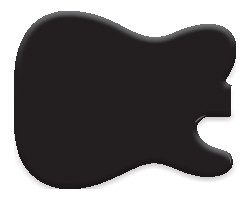 Fender Telecaster Unique Body Shape Fender Telecaster Unique Body Shape |
The Telecaster features a distinctive single-cutaway body with a flat top and squared edges, often called a “slab body.” This minimalist design reflects Leo Fender’s goal for a simple, mass-producible electric guitar. Launched in the early 1950s as the Broadcaster (later Telecaster), it was the first commercially successful solid-body electric guitar. Its design emphasized functionality and easy manufacturing. The shape, lacking the Stratocaster’s contours, was central to Fender’s vision of a durable, easily made guitar with a clear, bright tone that would define numerous music genres. |
Gibson SG®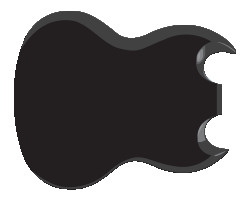 Gibson SG Unique Body Shape Gibson SG Unique Body Shape |
The Gibson SG features a thin, flat-top body with a double-cutaway for complete 22-fret access. Its pointed “horns” and beveled edges create an aggressive yet ergonomic design. Introduced in 1961 as a modern Les Paul iteration, the SG (“Solid Guitar”) was designed to compete with Fender’s contoured bodies. It quickly became iconic in its own right, known for its lighter weight and sharp body lines. This design was a move away from the bulkier Les Paul, aimed at modernizing Gibson’s image and improving playability, which the SG achieved with its thinner profile and enhanced upper fret access. |
Gibson ES-335® Gibson ES-335 Unique Body Shape Gibson ES-335 Unique Body Shape |
The Gibson ES-335 is characterized by its semi-hollow body, blending warmth and sustain. Its double-cutaway “thinline” design offers a versatile tonal palette, bridging the gap between hollow-body and solid-body guitars. Introduced in 1958, it was Gibson’s first semi-hollow body, aiming to offer the warmth of a hollow body with reduced feedback, suitable for louder volumes. The ES-335’s body shape is not only aesthetically pleasing but also functional, contributing to its rich, resonant tone and making it a favorite across genres from blues to rock and jazz. |
Gibson Flying V® Gibson Flying V Unique Body Shape Gibson Flying V Unique Body Shape |
The Flying V is defined by its radical V-shaped body, a futuristic design introduced in 1958 as part of Gibson’s Modernist series. With two pointed “wings,” it was Gibson’s attempt to inject modernity, appealing to the space-age fascination of the 1950s. Initially unsuccessful, it gained fame in the late 60s and 70s with rock and heavy metal. The bold design is visually striking and functional, allowing upper fret access and seated playing comfort. It has become an icon, synonymous with rock and metal for its aggressive look and sound. |
| Gibson Explorer® | The Explorer features a bold, angular body with sharp points and an asymmetrical design, projecting an aggressive aesthetic. Introduced in 1958 with the Flying V as part of Gibson’s Modernist Series, the Explorer aimed to attract with its futuristic design, reflecting the era’s space and innovation themes. Initially too radical for the market, it later found favor with rock and metal musicians in the 70s and 80s. Its large, flat body was a departure from traditional curves, offering a distinctive playing experience with balance and upper fret access. The Explorer’s ahead-of-its-time design became a symbol of rock and metal rebellion. |
PRS Custom 24® PRS Custom 24 Unique Body Shape PRS Custom 24 Unique Body Shape |
The PRS Custom 24 features a sleek, double-cutaway body with elegant curves and a slightly offset waist, providing modern aesthetics and comfortable playability. Introduced in 1985 by Paul Reed Smith, the Custom 24 was PRS Guitars’ first model and flagship instrument. Its design merged meticulous craftsmanship with innovative features like a 24-fret neck. The Custom 24’s body, typically mahogany with a maple top, often features figured maple, a PRS hallmark. Designed for versatile sound, sustain, and stability, it is favored by professionals across genres. |
Rickenbacker 360® Rickenbacker 360 Unique Body Shape Rickenbacker 360 Unique Body Shape |
The Rickenbacker 360 is known for its sleek, double-cutaway body with rounded edges and a distinctive “crescent moon” or “cat-eye” shape, giving it an art deco appearance. Introduced in the late 1950s as part of the Capri series, it became a Rickenbacker icon. Its design departed from traditional shapes, featuring a thinner semi-hollow body with an “R” shaped soundhole, contributing to its unique sound and look. The 360’s innovative body shape was visually appealing and ergonomically designed for comfort, favored by musicians seeking a distinctive look and bright, jangly Rickenbacker sound. |
Fender Jazzmaster®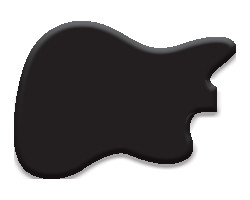 Fender Jazzmaster Unique Body Shape Fender Jazzmaster Unique Body Shape |
The Fender Jazzmaster has a distinctive offset-waist body with smooth curves and a flat top. Introduced in 1958, it was designed for jazz guitarists with innovative circuitry and mellow single-coil pickups. The offset body was ergonomic for seated players, common in jazz. However, it found its audience in surf rock in the 60s and later alternative and indie rock. The Jazzmaster’s body shape has endured, a testament to its timeless design. Note: While the Fender Jaguar shares a similar offset-waist design, it’s not identical; the Jaguar has a shorter scale and different body contouring. |
Ibanez JEM®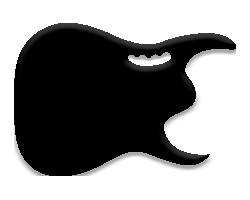 Ibanez Jem Unique Body Shape Ibanez Jem Unique Body Shape |
The Ibanez JEM features a stylized superstrat body with sharp cutaways, an exaggerated horn for upper fret access, and the signature “monkey grip” handle. Created with Steve Vai in the mid-1980s, the JEM was tailored to Vai’s technical and visual demands, a player-centric guitar. The shape is designed for high performance and comfort, reflecting Vai’s flamboyant style. A pioneering Ibanez model, it incorporated 24 frets and a floating tremolo, innovative for its time, setting new standards for rock guitar playability and design. |
Jackson Soloist® Jackson Soloist Unique Body Shape Jackson Soloist Unique Body Shape |
The Jackson Soloist features a contoured superstrat body with deep cutaways for high fret access and a slim profile for comfort. Introduced in the early 1980s, the Soloist was among the first neck-through-body guitars, enhancing sustain and stability, appealing to metal guitarists. Its design met the demand for high-performance guitars for hard rock and metal. Its refined, aggressive look and top-tier hardware solidified the Soloist as a Jackson mainstay, influencing many genre models. |
Gibson Firebird®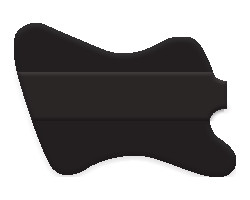 Gibson Firebird Unique Body Shape Gibson Firebird Unique Body Shape |
The Gibson Firebird features a unique offset body, like a reversed Fender Jaguar or Jazzmaster, with a larger lower bout and pointed “wings.” Its through-neck construction enhances its distinctive look. Introduced in 1963, designed by automotive designer Ray Dietrich to compete with Fender’s modern guitars. Dietrich’s radical design included a nine-ply walnut/mahogany neck-through build for sustain and a ‘reversed’ body, a departure for Gibson. Initially mixed reactions, the Firebird became a Gibson icon. |
Gretsch White Falcon®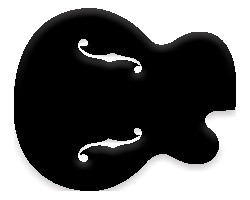 Gretsch White Falcon Unique Body Shape Gretsch White Falcon Unique Body Shape |
The Gretsch White Falcon features an opulent, large single-cutaway body with an arched top and oversized f-holes, resembling a grand acoustic but shallower like a semi-hollow electric. Conceived as the “Cadillac of guitars,” it began as a concept to showcase Gretsch’s craftsmanship and luxury. Popular demand led to production, making it a flagship model. The White Falcon’s elegant curves and grand size remain a symbol of guitar luxury, coveted by collectors and players. |
Ibanez Iceman® Ibanez Iceman Unique Body Shape Ibanez Iceman Unique Body Shape |
The Ibanez Iceman features a distinctive, aggressive body shape with sharp, angular contours and an asymmetrical double-cutaway. Its body is defined by a hooked “horn” on the lower cutaway and an offset waist, creating a bold, unconventional look that stands out from traditional guitar shapes and appeals to players seeking unique electric guitar shapes. |
Ibanez RG®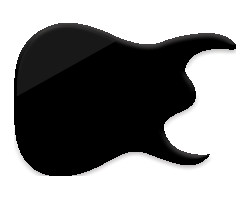 Ibanez RG Unique Body Shape Ibanez RG Unique Body Shape |
The Ibanez RG series features a sharp, angular superstrat body with deep cutaways for upper fret access and a sleek, aerodynamic look. Originating in 1987, RG (“Roadstar Guitar”) evolved from the Roadstar II series, modified for shredding and metal. The RG’s body shape was designed for high-speed playability and comfort. Known for pointed horns and a slim profile, the RG became synonymous with 80s/90s rock and metal virtuosity, a staple in Ibanez’s lineup for those prioritizing unique electric guitar shapes. |
Jackson Rhoads® Jackson Rhoads Unique Body Shape Jackson Rhoads Unique Body Shape |
The Jackson Rhoads model features an asymmetrical V-shaped body with sharp, pointed ends, one side longer, creating a distinctive, aggressive look. A collaboration between Randy Rhoads and Grover Jackson, it aimed to create a striking stage guitar, deviating from traditional shapes and offering unique electric guitar shapes. Introduced in the early 80s, the Rhoads model was among the first Jacksons, iconic in heavy metal. Its bold, angular look and upper fret access suited virtuoso metal guitarists. |
ESP Eclipse® ESP Eclipse Unique Body Shape ESP Eclipse Unique Body Shape |
The ESP Eclipse features a single-cutaway body reminiscent of the Les Paul, but with modern modifications and unique electric guitar shapes. It has a sleeker, contoured silhouette with a sharper cutaway and reduced thickness for comfort and playability. Introduced in the early 90s, the Eclipse met demand for a contemporary, versatile single-cut, suitable for various styles including hard rock and metal. Its aggressive lines and streamlined aesthetics blend classic inspiration with modern performance needs, a staple in ESP’s lineup. |
B.C. Rich Warlock® B.C. Rich Warlock Unique Body Shape B.C. Rich Warlock Unique Body Shape |
The B.C. Rich Warlock features an aggressive, angular body shape with sharp points and beveled edges, creating a very distinct appearance and unique electric guitar shapes. Introduced in the early 80s, the Warlock was designed by Bernie Rico of B.C. Rich for unconventional, edgy designs. Its bold, geometric lines and dramatic silhouette quickly became iconic in metal. |
Danelectro 59®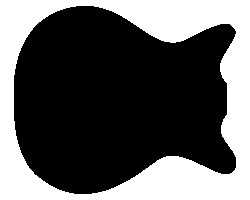 Danelectro 59 Unique Body Shape Danelectro 59 Unique Body Shape |
The Danelectro ’59 features a distinctive double-cutaway “shorthorn” body, with smaller, symmetrical horns than the ‘Longhorn’. Typically Masonite top and back with a poplar frame, known for lightweight resonance and unique electric guitar shapes. Introduced in the late 50s as an affordable line, renowned for unique construction and lipstick tube pickups, creating a jangly tone. Its simplicity and materials were due to Danelectro’s aim for cost-effective, playable instruments. The ’59 became a cult favorite, one of Danelectro’s most iconic models, celebrated for its unique electric guitar shapes. |
EVH Wolfgang®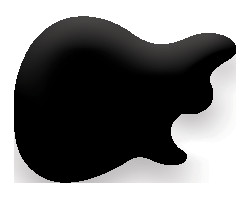 EVH Wolfgang Unique Body Shape EVH Wolfgang Unique Body Shape |
Designed by Eddie Van Halen, the EVH Wolfgang features a unique offset double-cutaway body with sleek, arched contours and a distinctive horn design for comfort and upper fret access, embodying unique electric guitar shapes. Developed with Fender under the EVH brand, after years of experimentation. The body shape, reminiscent of classics, includes custom touches like a “belly” cut and forearm contour, uniquely suited to Eddie’s groundbreaking style. |
Ernie Ball Music Man John Petrucci® Ernie Ball John Petrucci Unique Body Shape Ernie Ball John Petrucci Unique Body Shape |
The Ernie Ball Music Man John Petrucci signature series features a streamlined, modern double-cutaway body with rounded contours and a forearm scoop for enhanced comfort, demonstrating unique electric guitar shapes. Developed with John Petrucci, the body design reflects his ergonomic needs, with an angled upper horn for balance and a sculpted lower horn for upper fret access. Petrucci models often feature a recessed neck joint for playability. This evolving series reflects Petrucci’s input and Music Man’s craftsmanship. |
Gibson L-5®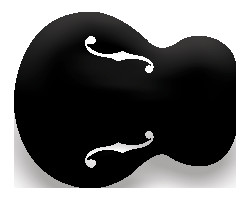 Gibson L5 Unique Body Shape Gibson L5 Unique Body Shape |
The Gibson L5 features a large, deep-bodied archtop design with a single-cutaway, f-holes, and a rounded Venetian-style body. The first f-hole archtop, designed by Lloyd Loar and introduced by Gibson in 1923, representing unique electric guitar shapes in its era. The L5’s body shape revolutionized guitar design, inspired by orchestral strings, increasing volume and projection for jazz bands. Its iconic, luxurious body shape symbolizes jazz’s golden age. |
Gretsch Duo Jet® Gretsch Duo Jet Unique Body Shape Gretsch Duo Jet Unique Body Shape |
The Gretsch Duo Jet is characterized by its single-cutaway, chambered body, reminiscent of the Les Paul, offering unique electric guitar shapes within the Gretsch lineup. Introduced in the early 1950s, the Duo Jet was Gretsch’s response to solid-body guitars, though semi-solid with a chambered mahogany body and maple top. Its comfortable size and shape, often black with white binding (“Black Beauty”), made it visually and sonically distinct in the 50s/60s. The Duo Jet’s balanced, resonant body shape is associated with iconic players like George Harrison, a Gretsch classic. |
B.C. Rich Mockingbird®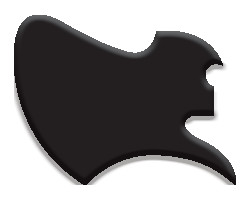 B.C. Rich Mockingbird Unique Body Shape B.C. Rich Mockingbird Unique Body Shape |
The B.C. Rich Mockingbird features an asymmetric, ornate body with a curved lower bout and extended upper horn, creating a characteristic profile and balance and showcasing unique electric guitar shapes. Created in the 70s by Johnny “Go-Go” Kallas and Bernie Rico, the Mockingbird was part of B.C. Rich’s foray into avant-garde designs, standing out in an era of innovation. The design captured the flamboyance of rock and metal, with visual flair and functionality, deep cutaways, and a comfortable contour. |
Schecter Hellraiser® Schecter Hellraiser Unique Body Shape Schecter Hellraiser Unique Body Shape |
The Schecter Hellraiser series features a superstrat body with an arched top, deep cutaways for upper fret access, and a contoured back for comfort, representing modern unique electric guitar shapes. Introduced in the mid-2000s, reflecting Schecter’s commitment to modern metal guitarists. The design merges classic strat playability with modern aesthetics and features. |
Fender Mustang® Fender Mustang Unique Body Shape Fender Mustang Unique Body Shape |
The Fender Mustang® features a distinctive short-scale, offset body with rounded contours and a compact design, offering unique electric guitar shapes in a smaller form factor. Its smaller body contributes to a lightweight, comfortable playing experience, favored by players preferring manageable instrument sizes. |
Fender Starcaster®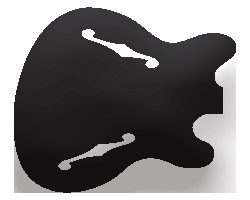 Fender Starcaster Unique Body Shape Fender Starcaster Unique Body Shape |
The Fender Starcaster features a unique offset semi-hollow body with a curved outline and asymmetrical cutaways, creating a standout silhouette and unique electric guitar shapes in Fender’s semi-hollow offerings. Launched in the mid-1970s, the Starcaster was Fender’s entry into the semi-hollow market, distinguished by its bold design, blending solid-body expertise with hollow resonance. The Starcaster’s large f-holes departed from Fender’s traditions, aiming for era aesthetics and the warmth of semi-hollow guitars. |
Charvel San Dimas®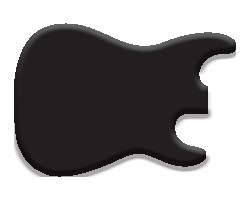 Charvel San Dimas Unique Body Shape Charvel San Dimas Unique Body Shape |
The Charvel San Dimas style guitar features a sleek superstrat body, known for deep cutaways for upper fret access and a contoured body for comfort, embodying unique electric guitar shapes refined for high performance. This model honors the hot-rodded guitars from Charvel’s San Dimas shop in the late 70s and early 80s. |
PRS Single Cut®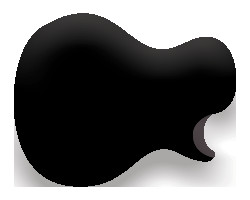 PRS Single Cut Unique Body Shape PRS Single Cut Unique Body Shape |
The PRS Singlecut features a thick, single-cutaway body with an elegantly carved top, providing unique electric guitar shapes with a blend of classic and modern design. Reminiscent of the Les Paul but with Paul Reed Smith’s touches, like a more contoured, comfortable body. Introduced in the late 1990s, the Singlecut was PRS’s entry into the single-cutaway market. Its slightly offset waist complements its classic outline, merging traditional aesthetics with modern playability. |
Parker Fly®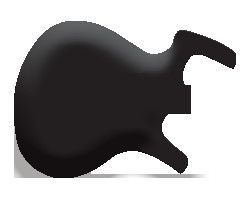 Parker Fly Unique Body Shape Parker Fly Unique Body Shape |
Known for its lightweight design and composite materials, the Parker Fly is a modern guitar with a truly unique shape, pushing the boundaries of unique electric guitar shapes with its innovative construction and form factor. |
Suhr Modern® Suhr Modern Unique Body Shape Suhr Modern Unique Body Shape |
The Suhr Modern features a sleek, ergonomic double-cutaway body with distinctive contouring for enhanced playability, offering unique electric guitar shapes in a modernized superstrat design. A modern evolution of the superstrat, with a sculpted, refined aesthetic. Introduced by Suhr Guitars in the late 2000s, the Modern caters to contemporary guitarists, combining upper fret access with balanced comfort, whether standing or sitting. Its body shape features a distinctive arm contour and ribcage cut. |
Mosrite Ventures®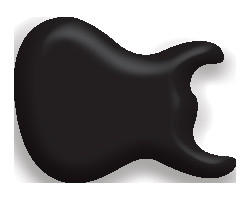 Mosrite Ventures Unique Body Shape Mosrite Ventures Unique Body Shape |
The Mosrite Ventures model exhibits a slim, double-cutaway body with sharp, pointed horns and a sweeping lower bout, embodying unique electric guitar shapes with a retro-futuristic vibe. A collaboration between Semie Moseley and The Ventures in the early 1960s. Its body, with deep cutaways, allowed upper fret access, while its sleek, aerodynamic aesthetic captured the Space Age and surf culture. It stood out from traditional shapes, symbolizing Mosrite’s innovative guitar craftsmanship. |
Gibson Les Paul Junior® (Double Cut) Double Cut Les Paul Jr Unique Body Shape Double Cut Les Paul Jr Unique Body Shape |
The Les Paul Junior Double Cut features a symmetrical double-cutaway body, offering unique electric guitar shapes in a more accessible Les Paul design. Introduced by Gibson in 1958 as an affordable Les Paul, the Junior’s double-cutaway design was part of a mid-century trend towards player-friendly shapes. Its no-frills design and robust build made it popular for its raw, powerful sound. |
Ibanez S Series®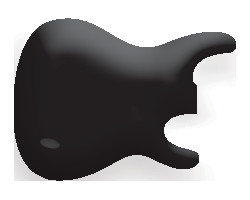 Ibanez S Series Unique Body Shape Ibanez S Series Unique Body Shape |
The Ibanez S Series, or Saber Series, is known for its sleek, contoured, thin body, offering unique electric guitar shapes focused on ergonomics and lightweight design. Introduced in the late 1980s, designed for lighter, ergonomic instruments with sustain and tone. Its slim profile tapers to a razor-thin edge, a departure from bulkier bodies, prioritizing comfort and playability without sacrificing sound quality. |
Dean ML®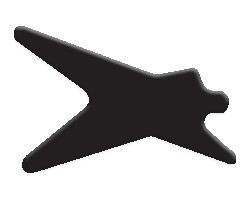 Dean ML Unique Body Shape Dean ML Unique Body Shape |
The Dean ML features a radical, oversized, pointed double-cutaway body, combining Flying V and Explorer elements, resulting in unique electric guitar shapes with a bold stage presence. Created by Dean Zelinsky in 1977, designed to be visually striking. Its equal-length, pointed “wings” provide unique balance. Iconic due to “Dimebag” Darrell Abbott of Pantera, associated with heavy metal and hard rock. |
Fender Thinline Telecaster® 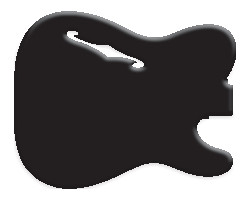 Fender Thinline Telecaster Unique Body Shape Fender Thinline Telecaster Unique Body Shape |
Fender Thinline models, like the Telecaster Thinline, feature a semi-hollow body with an f-hole, a variation on the solid-body shape, providing unique electric guitar shapes within the Telecaster family. Introduced in the late 1960s to reduce Telecaster weight and offer a tonal variation, blending solid-body twang with hollow-body resonance. Retains the Telecaster silhouette with an f-hole and different mass distribution, giving it a unique aesthetic. |
Steinberger GL® Steinberger GL Unique Body Shape Steinberger GL Unique Body Shape |
The Steinberger G&L series features a minimalist, compact headless body, a stark departure from traditional shapes, offering unique electric guitar shapes focused on functionality and portability. Developed by Ned Steinberger in the early 1980s, innovative design focused on function and playability. Headless design and direct-pull tuning system created a lighter, balanced instrument with tuning stability. Composite materials instead of wood, groundbreaking, durable, travel-friendly with a distinctive look and feel. |
Kiesel Aries®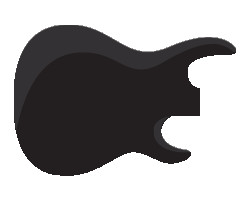 Kiesel Aries Unique Body Shape Kiesel Aries Unique Body Shape |
The Kiesel Aries features a sleek, modern superstrat body with an aggressive beveled top, deep rear cutaways, and sculpted horns for upper fret access, representing unique electric guitar shapes with cutting-edge aesthetics and playability. Reflects Kiesel’s contemporary design philosophy, blending aesthetics and playability. Part of the Carvin to Kiesel rebranding, emblematic of innovation and custom quality. |
Strandberg Boden®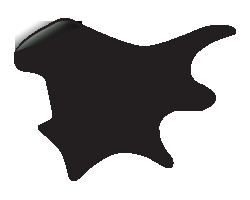 Strandberg Boden Unique Body Shape Strandberg Boden Unique Body Shape |
The Strandberg Boden features a distinct, compact, lightweight, ergonomic body with multi-faceted angles and curves, including arm bevel, ribcage contour, and extended upper horn, representing highly unique electric guitar shapes focused on ergonomics. Headless design, a radical departure from tradition, developed by Ola Strandberg. Originates from ergonomic research, aiming for comfort and playability for extended playing without strain. Popular with progressive metal guitarists for innovative features like the EndurNeck™ and body shape for balanced playing. |
Final Reflections on Unique Electric Guitar Shapes
From the classic Stratocaster contours to the futuristic Strandberg Boden, the evolution of electric guitar body shapes is evident. These 40 shapes are more than just instrument forms; they represent innovation, cultural evolution, and the artistic spirit that has defined the electric guitar in music history.
Each shape narrates a story of design philosophy, player needs, and aesthetic trends.
Whether it’s the timeless elegance of the Les Paul, the rebellious edge of the B.C. Rich Warlock, or the ergonomic precision of the Kiesel Aries, these designs have profoundly impacted music. They continue to inspire musicians and luthiers to push the boundaries of electric guitar design, ensuring that the quest for unique electric guitar shapes remains a vibrant part of musical innovation.


